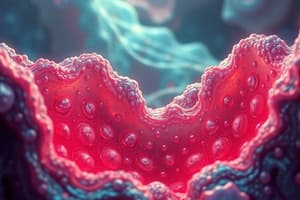Podcast
Questions and Answers
Which characteristic of epithelium allows it to achieve functional specialization?
Which characteristic of epithelium allows it to achieve functional specialization?
- Regeneration
- Avascular
- Cellularity
- Polarity (correct)
What is the primary function of simple squamous epithelium?
What is the primary function of simple squamous epithelium?
- Diffusion and filtration (correct)
- Mechanical protection
- Nutrient absorption
- Secretion of mucus
Why is epithelial tissue considered avascular?
Why is epithelial tissue considered avascular?
- It has a high blood supply to support cell growth.
- It does not require nutrients for regeneration.
- It lacks blood vessels and relies on diffusion. (correct)
- It is primarily formed from muscle cells.
Which type of epithelium is specialized for stretching?
Which type of epithelium is specialized for stretching?
What might occur due to abnormalities in epithelial cells?
What might occur due to abnormalities in epithelial cells?
Which type of epithelium typically contains goblet cells?
Which type of epithelium typically contains goblet cells?
What best describes the attachment of epithelial tissue to underlying structures?
What best describes the attachment of epithelial tissue to underlying structures?
Which organ systems would likely contain transitional epithelium?
Which organ systems would likely contain transitional epithelium?
Flashcards
Epithelium function
Epithelium function
Epithelium lines surfaces and cavities, protecting, absorbing, secreting, excreting, and sensing.
Epithelium characteristics
Epithelium characteristics
Epithelium is cellular, polar, attached, avascular, and regenerates rapidly.
Simple Squamous Epithelium
Simple Squamous Epithelium
A single layer of flat cells, best at diffusion and filtration.
Stratified Squamous Epithelium
Stratified Squamous Epithelium
Signup and view all the flashcards
Simple Cuboidal Epithelium
Simple Cuboidal Epithelium
Signup and view all the flashcards
Pseudostratified Epithelium
Pseudostratified Epithelium
Signup and view all the flashcards
Transitional Epithelium
Transitional Epithelium
Signup and view all the flashcards
Epithelial Tissue Pathology
Epithelial Tissue Pathology
Signup and view all the flashcards
Study Notes
Definition
- Epithelium is a type of tissue that lines surfaces and cavities throughout the body.
Characteristics
- Cellularity: Composed almost entirely of closely packed cells with minimal extracellular matrix.
- Polarity: Has an apical (top) surface and a basal (bottom) surface, leading to functional specialization.
- Attachment: Basal surface is anchored to the underlying connective tissue by a basement membrane.
- Avascular: Lacks blood vessels; nutrients are obtained through diffusion.
- Regeneration: High regenerative capacity; can rapidly replace damaged or lost cells.
Functions
- Protection: Shields underlying tissues from mechanical injury, pathogens, and dehydration.
- Absorption: Facilitates nutrient uptake in organs like the intestines.
- Secretion: Produces and releases substances such as enzymes, hormones, and mucus.
- Excretion: Helps in waste removal (e.g., in kidney tubules).
- Sensory Reception: Contains specialized cells for sensation (e.g., taste, smell).
Types of Epithelium
-
Simple Epithelium: Single layer of cells.
- Simple Squamous: Flat cells; functions in diffusion and filtration (e.g., alveoli of lungs).
- Simple Cuboidal: Cube-shaped; involved in secretion and absorption (e.g., kidney tubules).
- Simple Columnar: Tall, column-like; often contains goblet cells for mucus secretion (e.g., gastrointestinal tract).
-
Stratified Epithelium: Multiple layers of cells.
- Stratified Squamous: Thick layer; protects against abrasion (e.g., skin, esophagus).
- Stratified Cuboidal: Rare; found in some ducts (e.g., sweat glands).
- Stratified Columnar: Also rare; found in some glands and male urethra.
-
Pseudostratified Epithelium: Appears layered due to differing cell heights; often ciliated (e.g., respiratory tract).
-
Transitional Epithelium: Specialized for stretching; lines organs like the bladder.
Locations
- Covers body surfaces, lines cavities, and forms glands.
- Found in skin, respiratory tract, digestive tract, urinary tract, and reproductive organs.
Pathology
- Abnormalities in epithelial cells can lead to conditions like cancer (e.g., carcinoma), infections, and other diseases.
Definition
- Epithelium is a tissue type that lines various surfaces and cavities in the body.
Characteristics
- Cellularity: Comprised predominantly of closely packed cells with little extracellular matrix.
- Polarity: Features distinct apical (top) and basal (bottom) surfaces, enhancing functional specialization.
- Attachment: The basal surface connects to underlying connective tissue through a basement membrane.
- Avascular: Lacks blood vessels; relies on diffusion for nutrient acquisition.
- Regeneration: Exhibits a high capacity for regeneration, allowing for rapid repair of damaged cells.
Functions
- Protection: Safeguards underlying tissues from mechanical damage, pathogens, and dehydration.
- Absorption: Plays a crucial role in nutrient absorption, particularly in the intestines.
- Secretion: Responsible for the production and release of various substances, including enzymes, hormones, and mucus.
- Excretion: Aids in the removal of waste products, especially in kidney tubules.
- Sensory Reception: Contains specialized cells for sensory functions such as taste and smell.
Types of Epithelium
-
Simple Epithelium: A single layer of cells.
- Simple Squamous: Flat cells facilitating diffusion and filtration (e.g., alveoli in lungs).
- Simple Cuboidal: Cube-shaped cells involved in secretion and absorption (e.g., kidney tubules).
- Simple Columnar: Tall, column-like cells that often contain goblet cells for mucus production (e.g., gastrointestinal tract).
-
Stratified Epithelium: Consists of multiple cell layers.
- Stratified Squamous: Thick layers protecting against abrasion (e.g., skin, esophagus).
- Stratified Cuboidal: Rare, found in some ducts like sweat glands.
- Stratified Columnar: Also rare, located in select glands and male urethra.
-
Pseudostratified Epithelium: Appears multi-layered due to varying cell heights; typically contains cilia (e.g., respiratory tract).
-
Transitional Epithelium: Specialized to accommodate stretching, lining organs such as the bladder.
Locations
- Provides coverage for body surfaces, lines internal cavities, and forms glandular structures.
- Commonly found in the skin, respiratory tract, digestive tract, urinary tract, and reproductive organs.
Pathology
- Epithelial cell abnormalities can lead to serious conditions such as cancer (e.g., carcinoma), infections, and various diseases.
Studying That Suits You
Use AI to generate personalized quizzes and flashcards to suit your learning preferences.
Description
Explore the essential characteristics and functions of epithelial tissue in this quiz. From its cellular structure to its role in protection, absorption, and secretion, test your knowledge about how epithelium serves various purposes in the body. Perfect for students of biology and anatomy!




